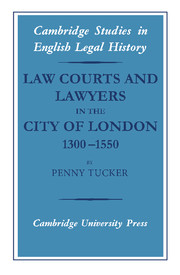Book contents
- Frontmatter
- Contents
- Acknowledgements
- List of abbreviations
- List of figures
- Introduction
- 1 The administration of the law by the city in context
- 2 The distinctiveness of city law and custom
- 3 The city law courts
- 4 The administration of the law in the city's courts: I
- 5 The administration of the law in the city's courts: II
- 6 Judges, jurors and litigants
- 7 The city's law officers
- 8 Legal representation in the city
- 9 The effectiveness of the administration of the law by the city
- 10 Interchange and exchange between the city and the common law
- Appendices
- Bibliography
- Index
1 - The administration of the law by the city in context
Published online by Cambridge University Press: 04 August 2010
- Frontmatter
- Contents
- Acknowledgements
- List of abbreviations
- List of figures
- Introduction
- 1 The administration of the law by the city in context
- 2 The distinctiveness of city law and custom
- 3 The city law courts
- 4 The administration of the law in the city's courts: I
- 5 The administration of the law in the city's courts: II
- 6 Judges, jurors and litigants
- 7 The city's law officers
- 8 Legal representation in the city
- 9 The effectiveness of the administration of the law by the city
- 10 Interchange and exchange between the city and the common law
- Appendices
- Bibliography
- Index
Summary
INTRODUCTION
A large, wealthy and well-organised entity, corporate if not in fact formally incorporated, medieval London was far more important than any single other English borough or county (throughout our period it was itself a county). For present purposes, the significance of this is that the city was in a better position than almost anyone or anything else in England to shape and influence its context and to protect its own interests. Conversely, it could not afford to ignore its context, and its very size and wealth meant that it tended to attract more attention than lesser cities and towns, some of it hostile or greedy, from other powerful individuals and organisations. The aim of this chapter, therefore, is to set London in its historical and legal context.
HISTORICAL CONTEXT
Economic and demographic context
Just how large London was is the subject of considerable doubt. A modest estimate would give it a population of about 25–35,000 in 1300, roughly equivalent to Bruges at the same period. This may be a considerable underestimate, however. Evidence of the intensification of land use in London during the thirteenth century suggests that, like England as a whole, its population grew rapidly after 1200. It might well have had as many residents in 1300 as it may have had by 1550, 80,000 or more. If so, it was among the ‘top ten’ European cities of the period.
- Type
- Chapter
- Information
- Law Courts and Lawyers in the City of London 1300–1550 , pp. 20 - 46Publisher: Cambridge University PressPrint publication year: 2007



